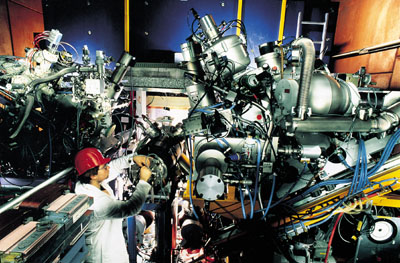In which direction do quarks point? The HERMES experiment using DESY’s HERA electron ring and an ingenious system to control the spin of the electron beam is poised to reveal new insights into the puzzle of what carries the proton’s spin.
In 1987 CERN’s European Muon Collaboration (EMC) revealed a puzzle that has been intriguing particle physicists ever since. The EMC measurements implied that the constituent quarks accounted for only some 30% of the nucleon spin. If the nucleon spin is not carried by quarks, where does it come from?
Several subsequent experiments at CERN and SLAC (Stanford) have given a more precise fix of this total quark contribution to the spin, but without being able to find where or what the missing spin is.
This is where HERMES comes in, a second-generation experiment at DESY’s HERA electron-proton collider which aims to study the origin of nucleon spin via electronnucleon scattering in which both the beam and target particles are spin-oriented (polarized). HERMES does not use HERA in its usual collider mode. It uses instead HERA’s electron (or positron) beams with a specially-designed target, and does not use the HERA proton beam.
Now well into its fourth year of data-taking, HERMES has demonstrated the validity and potential of its new approach and is now taking its first steps towards a solution of the spin puzzle by presenting a preliminary separation of the contributions of the individual quark flavours to the nucleon spin.
At collision energies where contributions due to the weak nuclear force are small enough to be neglected, a polarized electron or positron scatters off a polarized nucleon via the exchange of a virtual photon, which carries polarization from the incoming electron. Due to angular momentum conservation, this photon can interact with a quark in the nucleon only if this is polarized in the opposite direction.
The different spin orientations of beam and target, obtained by flipping the target polarization back and forth, reveal asymmetries in the different reaction rates which eventually yield the spin distributions of the nucleon’s constituents.
As well as its three valence quarks, the overall spin of the nucleon has contributions from its accompanying “sea” quarks and antiquarks, the gluons (which hold the quarks together), plus quark and gluon orbital angular momenta.
Up to now, most experiments have focused on measuring “inclusive” polarized lepton-nucleon scattering, where only the scattered lepton (electron or muon) is detected. This gives only an “overall” spin structure of the nucleon the spin carried by the quarks as a whole, without resolving the individual contributions of each quark.
The great power of HERMES lies in its ability to detect and identify the emerging hadrons in coincidence with the scattered lepton. Since high-energy forward-scattered hadrons are correlated with the struck quark, these hadrons “tag” the flavour of the struck quark. The contributions to the nucleon spin are determined not as a whole, but are separated into the individual quark flavours.
HERMES

The electrons pass through the gas target repeatedly, yielding plenty of clean data with minimal background contamination by scattering off other polarized or unpolarized nuclei (as is the case with solid targets).
Approved in 1993, the detector – a forward angle spectrometer of conventional design was assembled in the HERA East Hall during winter 1994/95 and commissioned in early summer 1995. It uses HERA’s 27.5 GeV electron/positron beam, naturally polarized transverse to the beam direction. Up- and downstream of HERMES, a pair of spin rotators turns the spins into the longitudinal and back to the transverse direction at every revolution a world premiere in a high-energy electron storage ring first achieved in 1994. This was an absolute precondition for the operation of HERMES.
The HERMES target consists of nuclear polarized gas fed into a thin-walled storage cell inside the HERA electron/positron ring. This new technique increases the surface target density by a factor of 100 compared to a free atomic beam, and allows high target polarization levels without dilution from unpolarized nuclei.
To minimize systematic errors, the target spin orientation is reversed at random intervals. So far, HERMES has been running with polarized helium-3 (1995) and hydrogen targets (1996-97), and deuterium in 1998. The target cell can also be filled with unpolarized gases for the investigation of further nucleon properties unrelated to spin.








